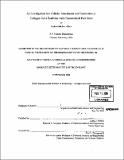| dc.contributor.advisor | Lorna J. Gibson. | en_US |
| dc.contributor.author | Albers, Andrew Michael, 1979- | en_US |
| dc.contributor.other | Massachusetts Institute of Technology. Dept. of Materials Science and Engineering. | en_US |
| dc.date.accessioned | 2005-09-27T18:49:32Z | |
| dc.date.available | 2005-09-27T18:49:32Z | |
| dc.date.copyright | 2004 | en_US |
| dc.date.issued | 2004 | en_US |
| dc.identifier.uri | http://hdl.handle.net/1721.1/28876 | |
| dc.description | Thesis (S.M.)--Massachusetts Institute of Technology, Dept. of Materials Science and Engineering, 2004. | en_US |
| dc.description | Vita. | en_US |
| dc.description | Includes bibliographical references (p. 99-104). | en_US |
| dc.description.abstract | Scaffolds fabricated from natural and man-made polymers have historically been used in partial- and full-thickness dermal wound beds to inhibit contraction and promote natural healing of tissue. By encouraging fibroblast migration and proliferation in the scaffolds, it is possible to reduce scar tissue formation and regenerate functioning dermis. A series of experiments were performed to determine the effects of average pore size and available surface area in a lyophilized Collagen-GAG scaffold on the infiltration and attachment of dermal fibroblasts. An updated design of the Cell Force Monitor (CFM) was used to quantify bulk cellular contractile behavior in seeded scaffolds. The effect of scaffold geometry on fibroblast contractile behavior was also investigated with the CFM. Results show that cellular seeding methods employed led to cellular agglomeration on the surfaces of the scaffolds, negating any possible correlation between internal available surface area and cellular attachment. It was also discovered that cell culture passaging techniques have more of an influence on cellular contractile behavior than scaffold pore size, given the seeding techniques employed in this study. No correlation was found between contractile behavior and scaffold geometry in the CFM. | en_US |
| dc.description.statementofresponsibility | by Andrew Michael Albers. | en_US |
| dc.format.extent | 121 p. | en_US |
| dc.format.extent | 8696165 bytes | |
| dc.format.extent | 8711447 bytes | |
| dc.format.mimetype | application/pdf | |
| dc.format.mimetype | application/pdf | |
| dc.language.iso | en_US | |
| dc.publisher | Massachusetts Institute of Technology | en_US |
| dc.rights | M.I.T. theses are protected by copyright. They may be viewed from this source for any purpose, but reproduction or distribution in any format is prohibited without written permission. See provided URL for inquiries about permission. | en_US |
| dc.rights.uri | http://dspace.mit.edu/handle/1721.1/7582 | |
| dc.subject | Materials Science and Engineering. | en_US |
| dc.title | An investigation into cellular attachment and contraction in collagen-GAG scaffolds with characterized pore sizes | en_US |
| dc.type | Thesis | en_US |
| dc.description.degree | S.M. | en_US |
| dc.contributor.department | Massachusetts Institute of Technology. Department of Materials Science and Engineering | |
| dc.identifier.oclc | 60425529 | en_US |
